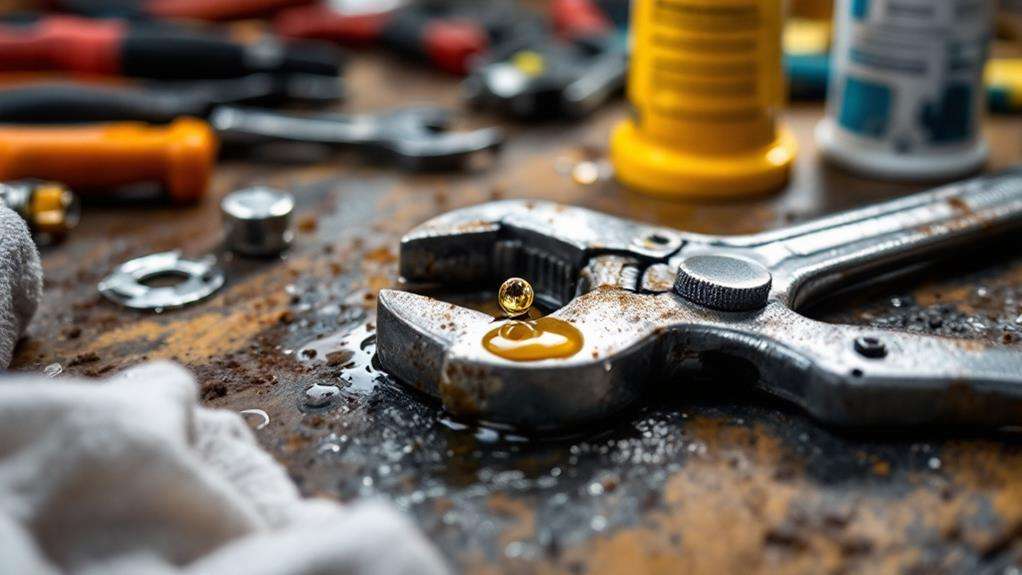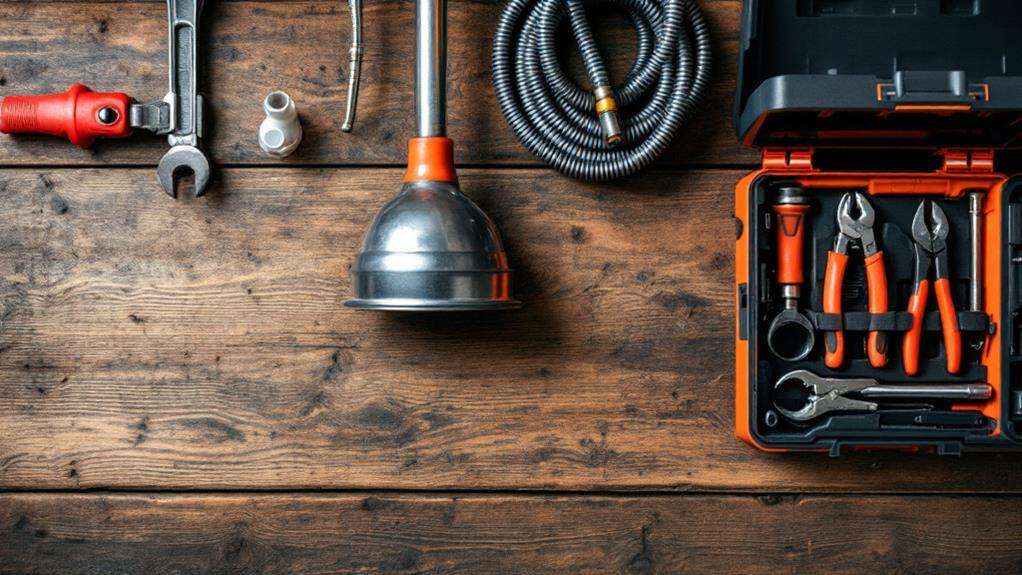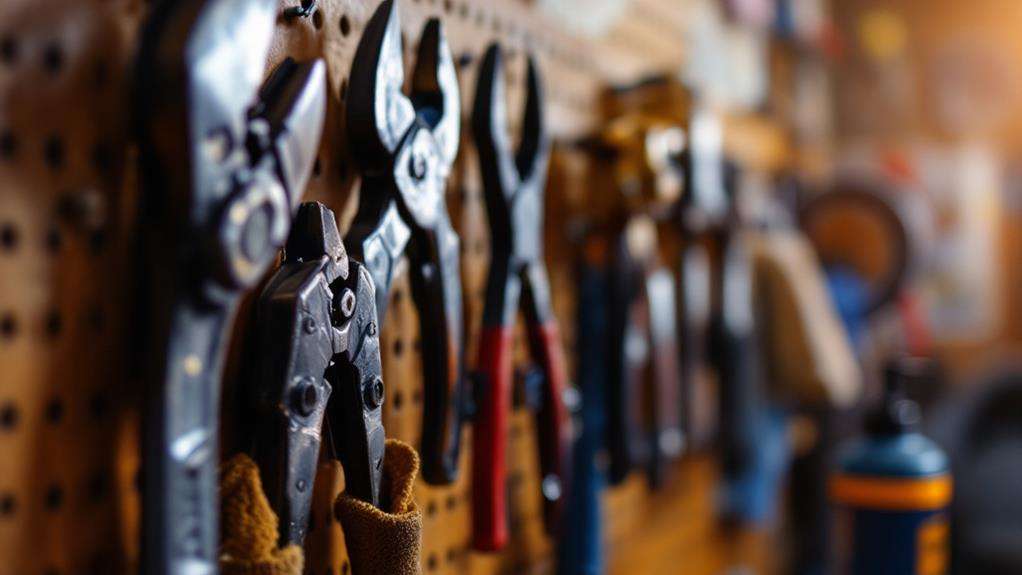How to Maintain and Care for Your Plumbing Tools
To maintain your plumbing tools, store them in a dry, temperature-controlled environment and clean them after each use. Wipe down tools with a clean cloth, disinfect when necessary, and thoroughly dry to prevent rust. Apply lubricating oil to moving parts and working surfaces. Regularly inspect your tools for wear, damage, or malfunction, addressing issues promptly. Invest in quality tools and protective cases for transport and storage. Follow tool-specific care guidelines, such as sharpening blades or calibrating gauges. By implementing these practices, you'll extend your tools' lifespan and guarantee they're always ready for the job. Proper maintenance is key to consistent, high-quality work and avoiding unexpected failures.
Proper Storage Techniques
Five key storage techniques can help you maintain your plumbing tools in top condition. First, store your tools in a dry, temperature-controlled environment to prevent rust and damage from humidity. This simple step is indispensable for long-term maintenance. Second, use separate compartments or cases for your tools. This prevents larger tools from scratching or damaging smaller, more delicate ones, ensuring they stay in good shape for a long time.
Third, invest in protective canvas bags or cases. These shield your tools from impact and abrasion during storage and transportation, extending their lifespan. Fourth, if you're using toolboxes on wheels, secure them with tie-downs when transporting. This prevents them from crashing around your vehicle, potentially causing damage. Ultimately, dedicate permanent storage boxes or compartments in your work vehicle. This keeps your tools organized and secure during travel, making it easier to find what you need quickly.
Cleaning and Drying Procedures
While proper storage is critical, keeping your plumbing tools clean and dry is equally important for their longevity. After each use, make it a habit to wipe down your plumbing tools and equipment with a clean, dry cloth. This simple step removes moisture, dirt, and debris that can lead to rust and corrosion.
For hand tools and power tools used in drain clearing or waste handling, take extra precautions. Disinfect these tools by soaking them in a diluted bleach solution. This process eliminates harmful bacteria and guarantees your tools are safe for future use.
Pay special attention to tools with moving parts, as moisture can cause them to seize up or malfunction. Thoroughly dry these components to prevent rust and maintain smooth operation. Once dry, apply a light coating of lubricating oil to the working surfaces of your tools. This step helps protect against corrosion and keeps your equipment functioning properly.
Remember that humidity is the enemy of plumbing tools. After cleaning and drying, store your tools in a climate-controlled environment to minimize exposure to moisture. By following these cleaning and drying procedures, you'll extend the life of your plumbing tools and confirm they're always ready for your next job.
Lubrication and Rust Prevention

Protecting your plumbing tools from rust and ensuring smooth operation requires regular lubrication and preventive measures. To keep your tools in top condition, you'll need to lubricate them regularly. Apply a light coating of oil or lubricant to the moving parts of your pipe wrench, basin wrench, and other plumbing tools. This will prevent premature wear and maintain smooth functionality.
Don't forget about your pipe cutters and other tools with adjustment mechanisms. These also need regular maintenance to prevent corrosion and rust. After each use, wipe down your tools with a rust-inhibiting spray or oil. This creates a protective barrier against moisture and oxidation.
Appropriate storage is essential for rust prevention. Keep your tools in a dry environment and consider using desiccant packets or dehumidifiers to minimize moisture. If you've used your tools in wet areas like sinks or toilets, clean and dry them thoroughly to remove any water or cleaning chemicals that could accelerate rust formation.
Regular Inspection and Maintenance
Regular inspection and maintenance of your plumbing tools is essential for safeguarding their longevity and safe operation. You should conduct a thorough check of your tools at least once a month, paying close attention to any signs of wear, damage, or malfunction. This practice will help you identify potential issues before they become serious problems, saving you time and money in the long run.
When performing your regular inspection, follow these key steps:
- Examine power cords and electrical components for cracks or exposed wires
- Check moving parts on hand tools for smooth operation and proper adjustment
- Inspect blades, gripping surfaces, and striking ends for damage or excessive wear
- Test battery-powered tools to guarantee they hold a charge effectively
Don't forget to clean your tools regularly, as this provides an opportunity to visually inspect them for any signs of damage or wear. Pay special attention to power tools, as they're more prone to electrical issues. The last thing you want is a dangerous shock while working on a plumbing project. By maintaining a consistent inspection routine, you'll keep your tools in top condition and warrant they're always ready for your next job.
Tool-Specific Care Guidelines

Different plumbing tools require specific care to maintain their functionality and longevity. Each tool plays a pivotal role in plumbing maintenance, and proper upkeep of these tools can help extend their lifespan and guarantee reliable performance.
For pipe wrenches, you'll want to clean and lubricate them regularly. This practice maintains smooth adjustability and prevents corrosion, which is indispensable for their effectiveness. When it comes to plungers, disinfect and dry them after each use. This keeps the rubber supple and prevents bacterial growth, ensuring they're always ready for the next job.
Store your drain augers in a protective case to prevent damage to the coiled cable. This simple step guarantees proper operation when you need it most. Don't forget about your pipe cutters – sharpen or replace worn cutting blades to maintain clean, burr-free cuts every time.
Lastly, calibrate your water pressure gauges periodically. Accurate readings are essential for proper diagnosis of plumbing issues, so this step shouldn't be overlooked. By following these tool-specific care guidelines, you'll save time and money in the long run, keeping your plumbing tools in top shape for years to come.
Safety Precautions During Maintenance
While proper tool care is essential, your personal safety during maintenance is paramount. When maintaining your plumbing tools, including your auger or snake, always prioritize safety to protect yourself and keep your equipment safe from damage. Follow these pivotal precautions:
- Unplug power tools and turn off the water supply before starting any maintenance work.
- Wear protective gear, including gloves and goggles, to prevent injuries.
- Guarantee proper ventilation when using chemical cleaners or lubricants.
- Store tools and materials securely to avoid tripping hazards.
By adhering to these safety measures, you'll not only protect yourself but also extend the life of your tools, saving you time and money in the long run. Remember to dispose of hazardous materials like used oil or solvents according to local regulations. This responsible approach confirms you're not only keeping yourself safe but also protecting the environment.
If you're ever unsure about maintaining a specific tool or feel uncomfortable performing maintenance, don't hesitate to consult a professional plumber. Their skillset can help you avoid potential safety risks and guarantee your tools remain in top condition for years to come.
Extending Tool Lifespan

Maintaining your plumbing tools isn't just about keeping them clean; it's about maximizing their lifespan. To extend the durability of your equipment, including plumbing snakes, make sure to store them in a temperature-controlled, dry environment. This prevents damage from humidity and protects your tools from rust and corrosion.
Regular cleaning and lubrication of moving parts is vital for reducing wear and tear. By keeping your tools well-oiled, you'll guarantee smooth operation for years to come. Don't forget to inspect your equipment daily for signs of damage, such as cracked handles or blunt blades. This proactive approach allows you to address issues before they become major problems.
Investing in high-quality, professional-grade plumbing tools made of durable materials is a smart choice. While they may cost more upfront, they'll provide reliable performance and a longer usable lifespan. Remember, proper tool maintenance saves you time and money in the long run by guaranteeing consistent, high-quality work and preventing unexpected failures. By following these practices, you'll keep your plumbing tools in top condition, ready for any job that comes your way.

